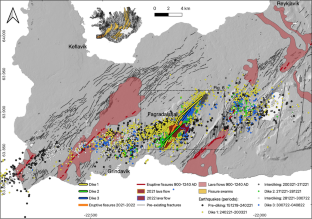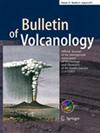2022年冰岛Fagradalsfjall火山喷发前和期间的形变、地震活动和监测反应
IF 3.2
2区 地球科学
Q1 GEOSCIENCES, MULTIDISCIPLINARY
引用次数: 1
摘要
冰岛Fagradalsfjall火山在2021年经历了两次堤坝入侵,其中一次导致了火山喷发,第三次堤坝入侵于2022年7月30日开始。防波堤区域内地震活动突然增加,大约有1700次自动检测到地震。地震持续数天,震感范围更广(最大震级5.3)。地震活动的时间和空间分布表明,这是由筑坝引起的,同时也引发了附近地区的地震活动,释放了储存的构造应力。8月2日进行的大地测量模拟结果显示,该岩脉顶部深度较浅(~1 km),岩浆流入速率较高(~49 m3 /s)。此外,考虑到地震活动的减少,发布了一个警告,称未来几天爆发新火山的可能性很高。第二天(8月3日),一条长约375米的裂缝开始喷发,初始喷发速度为32m3 /s。根据最优模型,堤面投影位置在喷发裂缝49 ~ 110 m范围内。我们提出了一个时间表的活动和监测反应在天之前和之后的爆发爆发。我们将这次筑堤和喷发之前发生的活动细节与fagradalsjall之前的事件进行比较,以提高对喷发前动荡的理解。本文章由计算机程序翻译,如有差异,请以英文原文为准。

Deformation, seismicity, and monitoring response preceding and during the 2022 Fagradalsfjall eruption, Iceland
Abstract Following two periods of dike intrusion in 2021 at Fagradalsfjall, Iceland, one of which led to an eruption, a third dike intrusion commenced on 30 July 2022. A sudden increase in seismicity occurred within the diking area, with approximately 1700 automatically detected earthquakes > M1 within 24 h. Strong earthquakes were felt over several days within a wider area (largest M W 5.3). The timeline and spatial distribution of seismicity suggested it resulted from diking, together with triggered seismicity in nearby areas releasing stored tectonic stress. Geodetic observations revealed displacements consistent with a dike intrusion, and geodetic modeling on 2 August revealed a best-fit model with a shallow top depth of the dike (~1 km), and high magma inflow rate (~49 m 3 /s). Also considering a decline in seismicity, a warning was issued that the likelihood of a new eruption in the coming days was high. An effusive eruption started the next day (3 August) on a ~375-m-long fissure, with an initial extrusion rate of 32 m 3 /s. The projected surface location of the dike (from the optimal model) was within 49–110 m of the eruptive fissure. We present a timeline of the activity and monitoring response in the days both preceding and following the eruption onset. We compare the details of the activity that occurred prior to this diking and eruption to the previous events at Fagradalsfjall to improve understanding of unrest preceding eruptions.
求助全文
通过发布文献求助,成功后即可免费获取论文全文。
去求助
来源期刊

Bulletin of Volcanology
地学-地球科学综合
CiteScore
6.40
自引率
20.00%
发文量
89
审稿时长
4-8 weeks
期刊介绍:
Bulletin of Volcanology was founded in 1922, as Bulletin Volcanologique, and is the official journal of the International Association of Volcanology and Chemistry of the Earth’s Interior (IAVCEI). The Bulletin of Volcanology publishes papers on volcanoes, their products, their eruptive behavior, and their hazards. Papers aimed at understanding the deeper structure of volcanoes, and the evolution of magmatic systems using geochemical, petrological, and geophysical techniques are also published. Material is published in four sections: Review Articles; Research Articles; Short Scientific Communications; and a Forum that provides for discussion of controversial issues and for comment and reply on previously published Articles and Communications.
 求助内容:
求助内容: 应助结果提醒方式:
应助结果提醒方式:


